
Accident is a town in Garrett County, Maryland, United States. The population was 338 at the 2020 United States census. Accident has been noted for its unusual place name. A person from Accident is called an "Accidental".

The Bloomington Viaduct spans the Northern Branch of the Potomac River connecting Bloomington, Maryland to Mineral County, West Virginia. The sandstone railroad bridge features three full center arches, each with a 56-foot span and a 28-foot rise. It is owned and operated by CSX Transportation on its Mountain Subdivision.
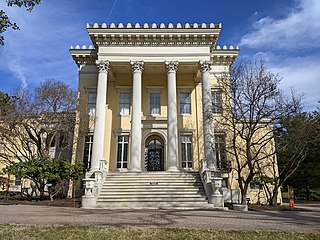
Evergreen Museum & Library is a historic house museum and research library in Baltimore, Maryland, United States. It is located between the campuses of the Notre Dame of Maryland University and Loyola University Maryland. It is operated by Johns Hopkins University along with Homewood Museum; both make up the Johns Hopkins University Museums.
Glamorgan, also known as Kittery Hill, is a large Queen Anne style house in Deer Park, Garrett County, Maryland. It is a large 2+1⁄2-story frame building built in 1888, as a summer house.

The Garrett Park Historic District is a national historic district located at Garrett Park, Montgomery County, Maryland. It's a 154-acre (62 ha) residential community incorporated in 1891, along the B & O Railroad. The older community includes a number of late Victorian homes. During the 1920s, the town expanded with a set of 40,640-square-foot (3,776 m2), "Chevy" houses built by Maddux, Marshall & Co. The district also includes a set of Prairie Style homes designed and built by Alexander Richter during the 1950s.

The Seneca Historic District is a national historic district located at Poolesville, Montgomery County, Maryland. The district comprises 3,850 acres (1,560 ha) of federal, state, and county parkland and farmland in which 15 historic buildings are situated. The Chesapeake and Ohio Canal, including Seneca Aqueduct, Lock No. 24, the adjacent lock house; as well as the Seneca Quarry and quarry masters house above the quarry also stand within the district and are also within Seneca Creek State Park. The 15 historic structures are surrounded by dependencies of various periods, in most cases dating from the period of the dwelling. There are slave quarters, smokehouses, springhouses, corn cribs, and tobacco barns.

The Inns on the National Road is a national historic district near Cumberland, Allegany County, Maryland. It originally consisted of 11 Maryland inns on the National Road and located in Allegany and Garrett counties. Those that remain stand as the physical remains of the almost-legendary hospitality offered on this well-traveled route to the west.
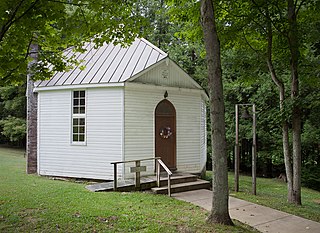
Mercy Chapel at Mill Run is an historic Carpenter Gothic-style church located at Selbysport, Garrett County, Maryland. It is a one-story, one room frame structure built on an octagonal plan above a coursed stone foundation. The interior of the chapel is a fine example of local craftsmanship and is virtually unchanged since the 1870s. Two small graveyard plots lie adjacent to the chapel. It is one of the most architecturally sophisticated and well-preserved octagonal buildings in Maryland, and one of only a dozen mid-19th-century octagonal buildings surviving in Maryland.
Borderside, also known as Brydon Mansion, was a historic home located at Bloomington, Garrett County, Maryland, United States. It was a 2+1⁄2-story, with 3-story tower, Italianate style brick structure that burned in the mid- to late 1970s. The tower had a pronounced bell-curve Mansard roof. It was built in 1870 for William A. Brydon, a coal and lumber dealer and member of the Maryland House of Delegates in 1867.

Creedmore is a historic home located at Mountain Lake Park, Garrett County, Maryland, United States. It is a large 2+1⁄2-story frame house built in the Queen Anne style. The house was built in 1903–1904 and has many distinctive architectural features, including oval windows, an unusual roofline, and an extensive use of shingling. It was constructed originally as a summer residence.
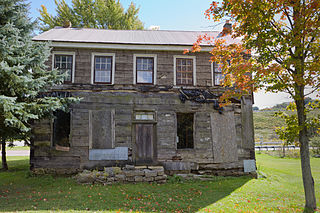
The Fuller-Baker Log House is a historic home located at Grantsville, Garrett County, Maryland, United States. It is a two-story rectangular log home, constructed of log planks about 8 inches (20 cm) thick; some are 14 to 16 inches (36–41 cm) broad and a few are 26 feet long. The house has been restored as an artist's studio and is an example of a log dwelling once common on the Allegheny frontier. Maryland's first governor, Thomas Johnson, owned the property when the house was built in 1815, but it is named for two later residents.
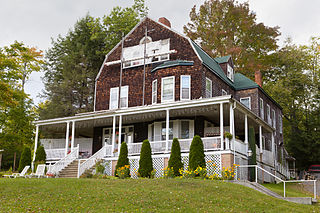
The Pennington Cottage is a historic home located at Deer Park, Garrett County, Maryland, United States. It is a 2+1⁄2-story, late-19th-century Shingle-Style frame structure, with a gambrel roof and a one-story porch that stretches across the principal facade and along portions of the sides. The house is entirely covered with dark wood shingles. It was built as a part of the Baltimore and Ohio Railroad's Deer Park Hotel complex, as the summer home of Baltimore architect Josias Pennington.

Kaese Mill is a historic grist mill located at Accident, Garrett County, Maryland, United States. It was constructed about 1868, and is a 2+1⁄2-story frame water-powered grist mill. It is the only fully operational water-powered grist mill in Maryland. It was built by Henry August Kaese, Sr., an immigrant miller from Germany who settled in Garrett County shortly after the American Civil War.

The Garrett County Courthouse is a historic county courthouse located at Oakland, Garrett County, Maryland, United States. It is a three-story, 1907–1908 neo-classical Renaissance Revival masonry structure in the form of a Latin Cross with a central rotunda and dome. The Courthouse was designed by James Riely Gordon (1863–1937), a New York architect who specialized in designing government buildings.
The Hoye Site or Hoye Prehistoric Indian Village site, now officially known as the Sang Run Site, is an archaeological site located within Garrett County, Maryland, near Oakland. Situated on the east bank of Youghiogheny River, this site was occupied by Native American groups beginning in the Archaic period and includes a significant period of occupation as a Monongahela village site from approximately 1000 to 1500 AD. It is the southernmost late prehistoric village known in the Youghiogheny drainage area and was the only known Late Woodland occupation in Garrett County at the time of its NRHP nomination.

Mountain Lake Park Historic District is a national historic district in Mountain Lake Park, Garrett County, Maryland. It consists of a group of 145 buildings lying within the town, which was launched in the 1880s as a summer resort and important as a center of the Chautauqua movement in Maryland. The district still includes many of the houses built by summer residents of town in the late 19th and early 20th centuries, built in various interpretations of the "Country Gothic" or Rural Queen Anne styles. Also within the district are several of the educational and recreational buildings constructed by the Mountain Lake Park Association, the Methodist-led group which owned and managed the town for many years after its founding in 1881.
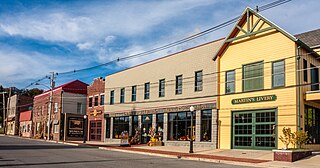
Oakland Historic District is a national historic district in Oakland, Garrett County, Maryland. It is an L-shaped area in the central and older section of Oakland containing 206 buildings. They reflect the evolution of this rural county seat from the mid-19th to mid-20th centuries. It includes the Garrett County Courthouse, but the majority of the buildings are residential of frame construction and positioned with deep setbacks from the street, surrounded by large lawns. Several churches and schools and a library are scattered in the district.
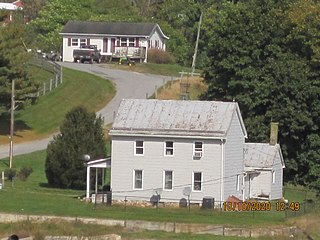
The Drummine Farm is a historic home and farm complex located at New Market, Frederick County, Maryland, United States. The main house was constructed about 1790 and is a 2+1⁄2-story structure of uncoursed fieldstone. The house retains Georgian stylistic influences in exterior and interior decorative detailing. The farm complex structures include a stone tenant house dated 1816, and four additional fieldstone buildings from the early 19th century: a smokehouse, a water storage house, a garden outhouse, and a large bank barn. Wooden farm buildings include a calf shed and a wagon shed with corn cribs from the late 19th century, a dairy barn with three cement stave silos from the 1930s, several sheds and garages, and a large pole barn.

Brooklandville House, or the Valley Inn, is a historic restaurant and tavern building, and a former inn, located in Brooklandville, Baltimore County, Maryland. It is a 2+1⁄2-story stone structure facing the former railroad and dating from about 1832. It is associated with the Baltimore and Susquehanna Railroad, which crossed the property just to the south.

Mt. Pleasant, also known as the Clemson Family Farm, is a historic home located at Union Bridge, Carroll County, Maryland, United States. It is a five-bay by two-bay, 2+1⁄2-story brick structure with a gable roof and built about 1815. Also on the property is a brick wash house, a hewn mortised-and-tenoned-and-pegged timber-braced frame wagon shed flanked by corn cribs, and various other sheds and outbuildings. It was the home farm of the Farquhar family, prominent Quakers of Scotch-Irish descent who were primarily responsible for the establishment of the Pipe Creek Settlement.





















